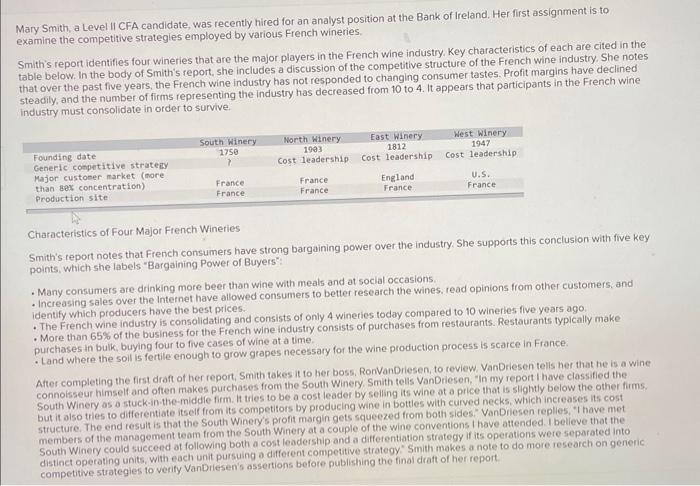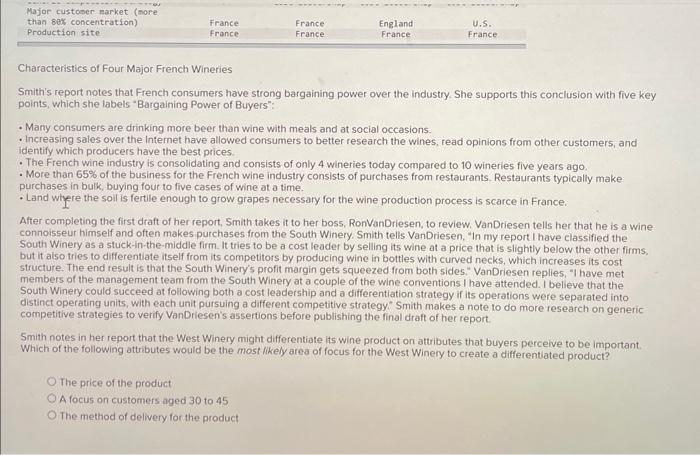Mary Smith, a Level II CFA candidate, was recently hired for an analyst position at the Bank of Ireland. Her first assignment is to examine the competitive strategles employed by various French wineries. Smith's report identifles four wineries that are the major players in the French wine industry. Key characteristics of each are cited in the table below. In the body of Smith's report, she includes a discussion of the competitive structure of the French wine industry. She notes that over the past five years, the French wine industry has not responded to changing consumer tastes. Profit margins have declined steadily, and the number of firms representing the industry has decreased from 10 to 4 . It appears that participants in the French wine industry must consolidate in order to survive. Characteristics of Four Major French Wineries Smith's report notes that French consumers have strong bargaining power over the industry. She supports this conclusion with five key points, which she labels "Bargaining Power of Buyers": - Many consumers are drinking more beer than wine with meals and at social occasions. - Increasing sales over the internet have allowed consumers to better research the wines, read opinions from other customers, and - The French wine industry is consolidating and consists of only 4 wineries today compared to 10 wineries five years ago. identify which producers have the best prices. - More than 65% of the business for the French wine industry consists of purchases from restourants. Restaurants typically make purchases in bulk, buying four to five cases of wine at a time . Land where the soil is fertile enough to grow grapes necessary for the wine production process is scarce in France. After completing the first draft of her report, Smith takes it to her boss. RonVanDriesen, to review. VanDriesen tells her that he is a wine South Winery as a stuck-in-the-middie firm. It tries to be a cost leader by selling its wine at a price that is slightly below the other firms but it also thies to differentiate itself from its competifors by producing wine in botties with curved necks, which increases its cost structure. The end result is that the South Winery's proft morgin gets squeezed from both sides. VanDiesen replles. 1 have met members of the management teom from the South Winery at a couple of the wine conventions i have attended. I believe that the South Winery could succeed of following both a cont leadership and a differentiation stratecgy if its operations were separated into distinct operating units, with each unit pursuing a different competitive strategy" Smith makes a note to do more research on genenic competitive strategies to verify VanDilesen's assertions before publishing the final draft of her report Characteristics of Four Major French Wineries Smith's report notes that French consumers have strong bargaining power over the industry. She supports this conclusion with five key points, which she labels "Bargaining Power of Buyers": - Many consumers are drinking more beer than wine with meals and at social occasions. - Increasing sales over the Intemet have allowed consumers to better research the wines, read opinions from other customers, and identify which producers have the best prices. - The French wine industry is consolidating and consists of only 4 wineries today compared to 10 wineries five years ago. - More than 65% of the business for the French wine industry consists of purehases from restaurants. Restaurants typically make purchases in buk, buying four to five cases of wine at a time. - Land where the soil is fertile enough to grow grapes necessary for the wine production process is scarce in France. After completing the first draft of her report. Smith takes it to her boss, RonVanDriesen, to review. VanDriesen tells her that he is a wine connoisseur himself and often makes purchases from the South Winery. Smith tells VanDriesen, "In my report I have classified the South Winery as a stuck-in-the-middle firm. It tries to be a cost leader by selling its wine at a price that is slightly below the other firms. but it atso tries to differentiate itself from its competitors by producing wine in bottles with curved necks, which increases its cost structure. The end result is that the South Winery's profit margin gets squeezed from both sides." VanDriesen replies, "I have met members of the management team from the South Winery at a couple of the wine conventions I have attended. I believe that the South Winery could succeed at following both a cost leadership and a differentiation strategy if its operations were separated into distinct operating units, with each unit pursuing a different competitive strategy. Smith makes a note to do more research on genetic competitive strategies to verify VanDriesen's assertions before publishing the final draft of her report. Smith notes in her report that the West Winery might differentiate its wine product on attributes that buyers perceive to be important. Which of the following attributes would be the most likely area of focus for the West Winery to create a differentiated product? The price of the product A focus on customers aged 30 to 45 The method of delivery for the product








